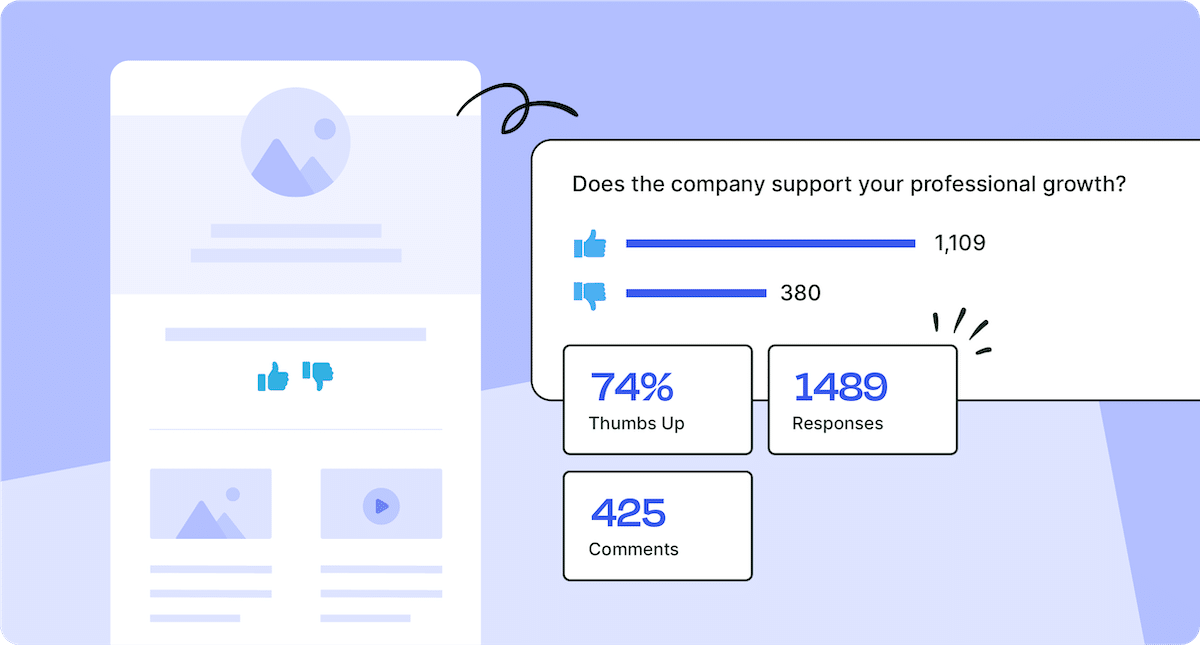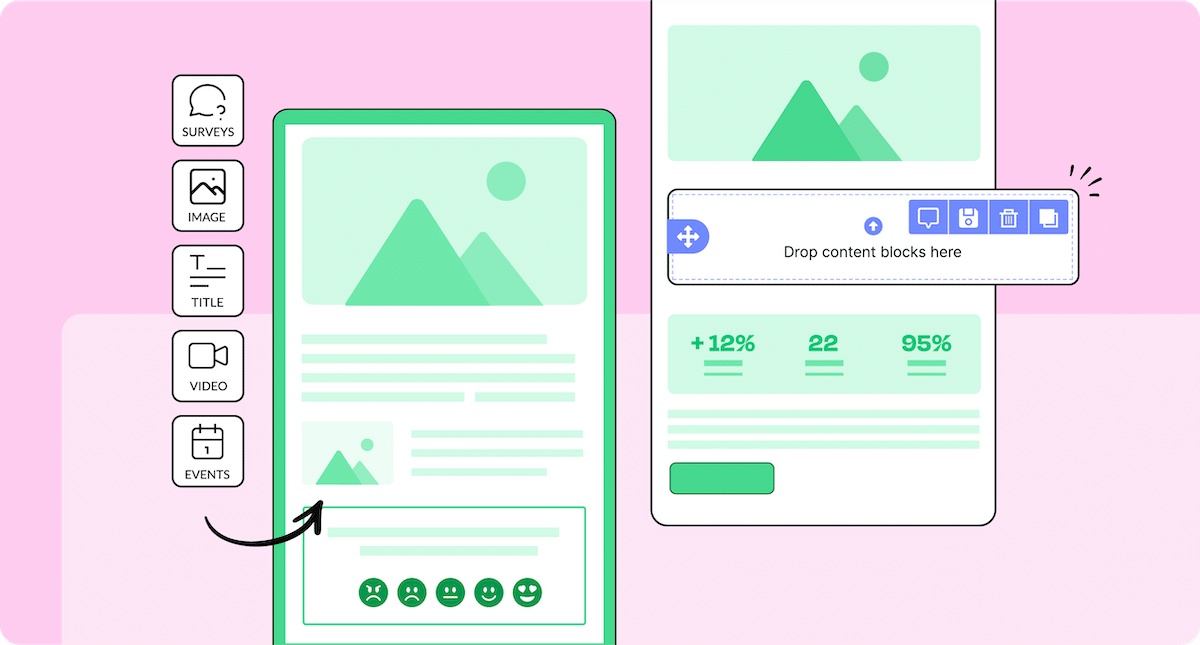In an age where AI and automation dominate inboxes, it’s easier than ever to send internal messages. At the same time, it’s harder to make your comms cut through the clutter. This article covers how to create an employee newsletter content strategy—even with limited resources.
Your employee newsletter is a direct line to the people who make your business run. But here’s the thing: most employee newsletters fall flat. They’re often too long, too dull, or too disconnected from what employees actually care about.
If you’re finding that most of your newsletters end up unread or auto-deleted, it might be time to rethink your employee newsletter content strategy. Done right, an employee newsletter can ignite engagement and boost internal communication ROI.
The key is intentional, thoughtful, and—yes—human-centered employee newsletter content planning. This guide is packed with employee newsletter content tips, real-world employee newsletter content strategy examples, and actionable employee newsletter content best practices. You’ll also find practical company newsletter content tips and insights into employee newsletter content planning.
Why Employee Newsletter Content Strategy Is So Important
If you’re treating your employee newsletter like an afterthought, it’ll get treated like one. A well-defined staff newsletter content strategy ensures your content is:
- Purpose-driven: Serves a larger goal—whether it’s informing, engaging, or recognizing or solidifying employee newsletter content guidelines.
- Employee-centric: Tailored to the needs, roles, and preferences of your internal audience.
- Consistent: Reinforces culture and messaging while maintaining a predictable structure.
- Trackable: Measure employee engagement and other key KPIs to understand your employee newsletter content performance.
- Inclusive: Reaches everyone, no matter their location, department, or role.
Most importantly, a strategic approach allows you to move beyond random updates to connected storytelling for an internal communications experience centered on effective employee newsletter content planning. Let’s look at how to do that.
Revive employee engagement with targeted, interactive emails and newsletters
Book a 15 minute call with one of our team members
10 Best Employee Newsletter Content Strategies With Examples
Below, we’ve outlined 10 employee newsletter content strategy examples to help you elevate your internal comms.
These tips are rooted in employee newsletter content best practices and designed to help you craft impactful messages that resonate. Whether you’re looking to boost morale, drive action, or simply improve your internal company newsletter content.
1. Start with a clear objective for every issue
A strong employee newsletter content strategy starts with knowing what each issue should achieve. That’s the foundation of all great employee newsletter content planning.
Why it works: Clear objectives sharpen your message and ensure every piece of content has a purpose.
Example: Focus an employee newsletter content strategy around a single theme—like quarterly wins or upcoming policy changes—so your content feels cohesive, not chaotic.
Steps to action:
- Before writing, define what you want employees to know, feel, or do.
- Draft 2–3 core messages to guide content selection.
- Align each section with these goals.
Considerations:
- Avoid cramming multiple disconnected themes into one issue.
- Keep goals employee-focused, not just leadership-driven.
PRO TIP: Use ContactMonkey’s analytics dashboard feature to see which messages perform best over time—refine your employee newsletter content strategy with data, not guesswork.
2. Segment your internal audience for relevance
Not all employees want—or need—the same updates. That’s why audience segmentation is a core part of any effective staff newsletter content strategy.
Why it works: Different teams care about different things. Segmentation ensures everyone receives what’s most useful to them.
Example: Send role-specific content to sales, operations, and HR within one unified newsletter using smart content blocks.
Steps to action:
- Group employees by department, location, or role.
- Use merge tags to tailor greetings and content sections.
- Track engagement by audience group.
Considerations:
- Make sure employees know why they’re receiving personalized content.
- Keep core messages consistent to maintain alignment across the org.
PRO TIP: Use ContactMonkey’s audience segmentation feature to dynamically deliver the right staff newsletter content—without creating multiple versions from scratch. You can also use these audience segmentation for internal communications examples to help you effectively organize your audiences.
Organize your contacts with list management
Save time managing employee lists by syncing everything in one place.
3. Make it visually appealing
One of the most overlooked employee newsletter content tips is to focus on a more polished, editorial design. A clean layout can increase engagement and keep employees on your message longer.
Why it works: The right kind of employee newsletter design grabs attention and makes information easier to digest.
Example: Use icons, photos, and white space to highlight team wins or new tools.
Steps to action:
- Choose a branded, mobile-responsive template.
- Use no more than 3 fonts and 2–3 main colors for consistency.
- Break up text with visuals, bullets, and bold headers.
Considerations:
- Ensure accessibility (contrast, font size, alt text).
- Avoid heavy image-only emails—some filters block them.
PRO TIP: ContactMonkey’s drag-and-drop email builder feature makes it easy to build stunning internal newsletter content—no design skills required.
4. Feature employee stories and recognition
When you’re building a people-first employee newsletter content strategy, nothing hits home like authentic employee stories and peer shout-outs.
Why it works: Recognition builds community and morale. Employee stories bring authenticity to your corporate newsletter content.
Example: Feature a monthly “Meet the Team” profile or peer-nominated kudos section.
Steps to action:
- Create a submission form for employee stories.
- Schedule regular shout-outs (birthdays, anniversaries, wins).
- Include photos or fun facts for added personality.
Considerations:
- Ensure inclusivity—celebrate across departments and levels.
- Follow your employee newsletter content guidelines on tone and imagery.
PRO TIP: Use ContactMonkey’s employee feedback features to let employees nominate peers for recognition—it keeps content fresh and participatory. Plus, use these fun and creative employee recognition ideas to keep your content engaging and interesting.
Pulse surveys that actually engage employees
Get instant feedback with our interactive survey tools—without switching platforms.
5. Share business updates transparently
Your team deserves transparency—but it’s your job to make it engaging. Business updates are a cornerstone of a solid staff newsletter content strategy.
Why it works: Transparency builds trust. Employees want to understand how their work fits into the bigger picture.
Example: Employee newsletter content best practices center around transparent updates. include an executive’s quarterly video update paired with a visual company progress dashboard to keep teams informed and aligned.
Steps to action:
- Interview leaders for key takeaways.
- Use graphs or visuals to explain data simply.
- Keep updates concise and jargon-free.
Considerations:
- Context is key—explain what numbers mean and why they matter.
- Balance positive and challenging news to maintain credibility.
PRO TIP: Add a “Why this matters to you” blurb beneath updates to tie the message to employees’ roles. This will help exemplify your employee newsletter content strategy, while connecting IC to individual employees’ roles.
6. Include quick, actionable calls to action (CTAs)
Want employees to take action? Clear CTAs are one of the most practical employee newsletter content tips you can use.
Why it works: A great employee newsletter content strategy means nothing if employees don’t act on it. CTAs help guide behavior.
Example: “Register for benefits info session by Friday” with a bright CTA button.
Steps to action:
- Use bold, action-oriented language.
- Keep CTAs short—one clear ask per section.
- Track clicks to see what’s working.
Considerations:
- Don’t overwhelm employees with too many CTAs in one email.
- Place buttons strategically—above the fold and after context.
PRO TIP: Use ContactMonkey’s CTA buttons and real-time tracking to fine-tune what drives the most interaction. Take advantage of more internal communication best practices, to make sure that you’re using the right tactics and approaches.
7. Incorporate interactive content
From pulse surveys to emoji reactions, interactive content boosts engagement and gives you real feedback—making it essential for modern employee newsletter content planning.
Why it works: Interactive content invites participation, increasing engagement and emotional investment.
Example: Embed a 1-question pulse survey: “How are you feeling this week?” with emoji responses.
Steps to action:
- Add polls, quizzes, or sliders to gauge sentiment.
- Use GIFs or hover elements to highlight updates.
- Review response data for actionable insights.
Considerations:
- Keep interactive elements simple and quick to respond to.
- Avoid overuse—interactivity should enhance, not distract.
PRO TIP: Try gamification for employee engagement in your internal newsletter content strategy like a “Choose Your Own Update” format. This can link to different content paths so employees control their experience. Pair this with proven employee newsletter content tips and types of employee content that drive the most engagement for the best results.
8. Create themed sections for consistency
Recurring sections simplify your employee newsletter content planning and give your newsletter a familiar, reader-friendly format.
Why it works: Recurring sections reduce planning time and give readers something to look forward to.
Example: Regular segments like “Leadership Q&A,” “Tools We Love,” or “Customer Kudos.”
Steps to action:
- Develop 3–5 recurring sections aligned with your content pillars.
- Rotate features based on engagement levels and seasonality.
- Brand sections with icons or color headers for recognition.
Considerations:
- Keep themes flexible—avoid becoming too rigid.
- Use data to update your employee newsletter content strategy examples.
PRO TIP: Use ContactMonkey’s internal communication templates to replicate themed sections quickly and streamline your employee newsletter content planning.
Unlock 100+ templates for instant use
From HR emails and newsletters, we’ve got all the templates you need.
9. Keep the tone conversational—not corporate
You’re not writing for a boardroom. Conversational writing keeps content approachable and human—core to any great employee newsletter content strategy.
Why it works: A relaxed tone builds connection and trust, especially in remote or hybrid workplaces.
Example: Replace “In accordance with policy” with “Here’s the scoop on our new approach.”
Steps to action:
- Write like you’re talking to a colleague—friendly, clear, respectful.
- Use contractions, everyday words, and first-person phrasing.
- Include informal intros or closing notes from leaders.
Considerations:
- Match tone to your company culture—don’t overdo the casual vibe if it doesn’t fit.
- Review for clarity—conversational doesn’t mean sloppy.
PRO TIP: Test formal vs. informal intros using ContactMonkey to see which tone resonates with your audiences and best suits your internal company newsletter content.
10. Ask for feedback, then actually implement it
The best way to improve your employee newsletter content strategy? Ask employees what they want.
Why it works: Feedback makes your newsletter a two-way communication channel. It shows you care—and helps you improve your employee newsletter content strategy.
Example: End each newsletter with a one-click feedback bar: “Was this useful?” 👍👎
Steps to action:
- Include simple feedback prompts regularly.
- Share what you’re changing based on responses.
- Offer multiple ways to provide input—forms, surveys, and emoji ratings.
Considerations:
- Don’t just collect data—act on it.
- Be transparent about what changes are (and aren’t) possible.
PRO TIP: Create a quarterly “You Said, We Did” section to show how feedback shapes your internal company newsletter content and your employee newsletter content strategy.
5 Reasons Why You Should Use a Modern Internal Comms Platform
Modern internal comms platforms can transform your employee newsletter content strategy—making it easier to segment, personalize, and measure your impact. But are they right for every team?
Here’s a look at the reasons why an internal comms platform improves your internal newsletter content (without adding complexity):
- Targeted messaging: Segment content by role, location, or department for more relevant employee newsletter content.
- Real-time analytics: Track opens, clicks, and engagement to refine your employee newsletter content strategy over time.
- Interactive features: Add polls, reactions, and feedback forms to boost engagement and encourage two-way communication.
- Easy design tools: Drag-and-drop editors make it simple to build branded, eye-catching newsletters—no coding needed.
- Seamless integration: Send directly from a native email platform with the Outlook or Gmail integration feature, streamlining your workflow and your employee newsletter content planning.
A modern internal comms platform can be a game-changer for your employee newsletter content strategy. Book a free demo today to see how ContactMonkey can help you create smarter, more impactful newsletters—without the guesswork.


